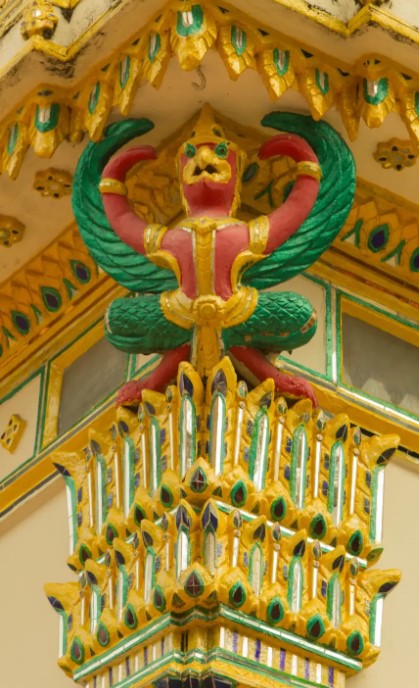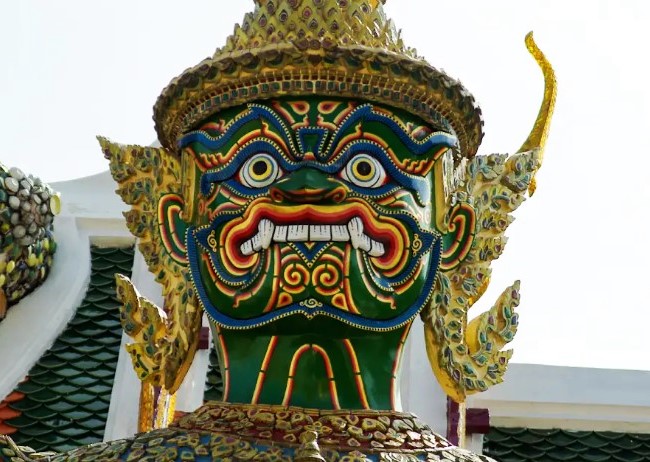By Ricky Fernandez
BANGKOK, THAILAND – As tourists and locals enter one of Thailand’s 40,000 temples, they pass by a set of supernatural security guards.
Tall, viscous mythical creatures with fangs protruding from their mouths. Or short, eccentric statues resembling Chinese warriors.
The door guards are not just photogenic figures to feature on your next Instagram post, they represent the long history of trade and the interweaving of Hindu and Chinese cultures into the fabric of Thailand.
“When you look closely, you can see that the architecture is a mix of Southeast Asia, Thai, Cambodian, Hindu and Chinese,” says Neng, a local tour guide.
“There is especially a lot that is the same in Hindu and Buddhist religions, so when you come to the temple you can see some of both influences,” he says.
Ancient trade routes facilitated the ‘Indianisation’ of Southeast Asia between the 1st and 6th centuries CE. Indian culture, religion, language, literature and philosophy were injected into the region during this period.
This period of trade brought about the spread of Buddhism, which is now the religion that 94.5% of Thai locals practice.
Chinese culture followed suit with widespread settlement of Chinese people from the 13th century onwards and the more recent ‘golden age’ of trade with China in the early 19th century.
Neng says “China and Thailand are very close. This goes back to the early kings of Thailand.”
“Many statues and pieces are given to Thailand as gifts from China,” he explains.
Along with trade came the blending of foreign art forms into traditional Thai architecture and decoration.

Temples were adorned with patterns attributed to these foreign cultures and guarded by captivating creatures from Hindu and Chinese mythology.
In Thailand, temples (or wat) are places where the divine intersects with the earthly realm. Temple guards serve as protectors of the sacred grounds.
The creatures’ fearsome appearances are believed to ward off evil spirits, bad fortune, and negative energy, ensuring the temple remains a sacred and safe space for worshippers.
“Every door or entrance, we have a guardian because people still believe in animism,” says Neng.
Many temples in Thailand incorporate Chinese deities and legendary creatures, often seen in their traditional forms: grandiose, powerful and protective.
‘Singha,’ the namesake of Thailand’s most well-known beer, draws inspiration from Chinese guardian lions and is commonly seen in groups guarding the entrances to temples and palaces such as the ‘Wat Phra Kaew’ in Bangkok. The fierce expressions and muscular bodies of these prominent guardians are meant to intimidate evil spirits and intruders.
Dragons, as powerful mythological beings, are usually depicted as serpentine creatures that curl around pillars or statues. In Chinese mythology, dragons are wise creatures, associated with water, rain and prosperity. The presence of the dragon is a reminder of the divine forces controlling natural elements, and it is believed to safeguard the temple from disasters and misfortune.
Unsurprisingly, due to a shared Indian origin, the similarities between Hindu and Buddhist deities are perfectly translated through traditional temple architecture.
Perhaps the most iconic Hindu creatures found in Thai temples, Yak or Yaksa are benevolent nature spirits or guardians that are often built over 10 feet tall. In Hindu and Thai mythology, these creatures are depicted as powerful, humanoid beings that protect the natural world from evil. In some temples, Yaksa statues can be seen holding large staffs or weapons and standing guard at either side of a door or walkway.
The Garuda is the national emblem of Thailand. It is a bird-man hybrid often depicted on bank notes, government buildings or the apex of Thai temples. Its appearance is a human body with the wings, legs and beak of a bird. The Garuda is the fearsome king of the birds and transports the Hindu God, Vishnu.
The Naga, a serpent-like creature, is one of the most revered and widely represented creatures in Thai and Hindu architecture. In Hindu mythology, Nagas are associated with water and the underworld, but in Thai culture, they are seen as protectors of the Buddhist faith. Large Naga statues often line stairways leading up to temple entrances like the Wat Phra That Doi Suthep, their coiled bodies representing spiritual ascent.
In many temples, the Naga (Hindu) is depicted alongside the Singha (Chinese), combining the power of water and the protective strength of the earth. This blend of influences reflects Thailand’s history as a crossroads of powerful civilisations, where ideas from across Asia converged.

Editor: The Southeast Asia Festival www.seasia.co.nz returns at Auckland Showgrounds, 8 March 2025. FREE ENTRY.
With MORE unique Southeast Asian foods, MORE traditional performances and MORE immersive activities!
It’s like a day trip to Southeast Asia ✈️
HUNDREDS of food options and non-stop entertainment from Philippines, Malaysia, Thailand, Indonesia, Vietnam and more!
FREE parking at Cornwall Park (1 min walk)
Auckland Showgrounds, 217 Green Lane West, Epsom























